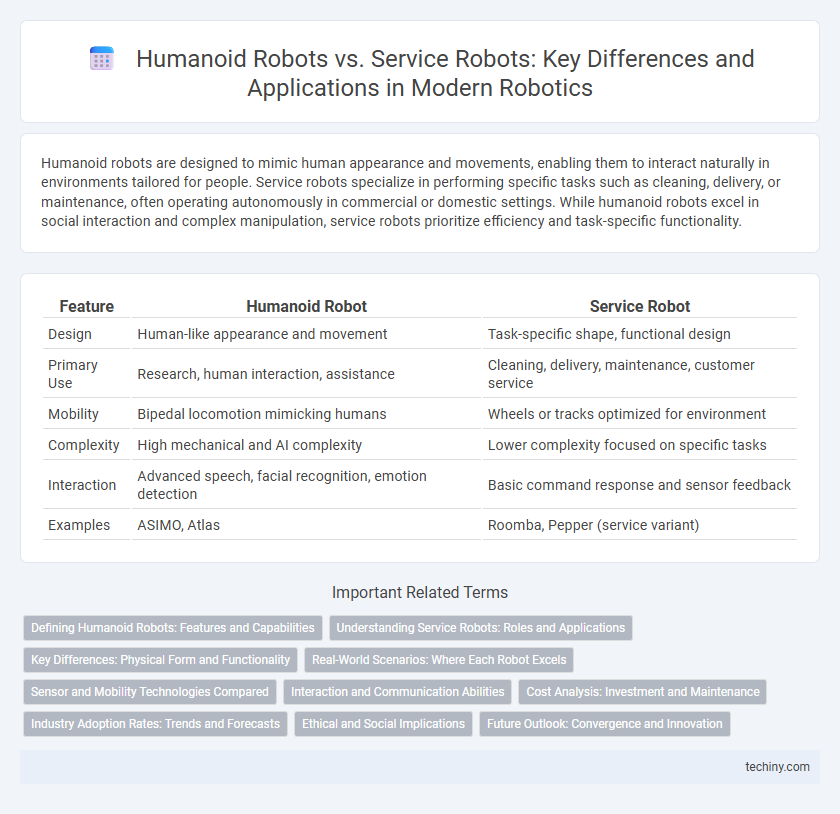Humanoid robots are designed to mimic human appearance and movements, enabling them to interact naturally in environments tailored for people. Service robots specialize in performing specific tasks such as cleaning, delivery, or maintenance, often operating autonomously in commercial or domestic settings. While humanoid robots excel in social interaction and complex manipulation, service robots prioritize efficiency and task-specific functionality.
Table of Comparison
| Feature | Humanoid Robot | Service Robot |
|---|---|---|
| Design | Human-like appearance and movement | Task-specific shape, functional design |
| Primary Use | Research, human interaction, assistance | Cleaning, delivery, maintenance, customer service |
| Mobility | Bipedal locomotion mimicking humans | Wheels or tracks optimized for environment |
| Complexity | High mechanical and AI complexity | Lower complexity focused on specific tasks |
| Interaction | Advanced speech, facial recognition, emotion detection | Basic command response and sensor feedback |
| Examples | ASIMO, Atlas | Roomba, Pepper (service variant) |
Defining Humanoid Robots: Features and Capabilities
Humanoid robots exhibit advanced bipedal locomotion, articulated limbs with dexterous manipulators, and sensory systems that mimic human perception, enabling complex interactions within human environments. Their capabilities include natural language processing, gesture recognition, and adaptive learning algorithms, facilitating tasks that require social engagement and precision. Unlike service robots designed for repetitive, predefined functions, humanoid robots are engineered for versatility and dynamic problem-solving in unstructured settings.
Understanding Service Robots: Roles and Applications
Service robots perform specialized tasks such as cleaning, delivery, and patient assistance, designed to operate in human environments with practical functionalities. Unlike humanoid robots, service robots prioritize efficiency and reliability over human-like appearance, often featuring task-specific designs like autonomous vacuum cleaners or medical robots. These robots enhance industries such as healthcare, hospitality, and logistics by automating repetitive or hazardous tasks, improving operational productivity and safety.
Key Differences: Physical Form and Functionality
Humanoid robots are designed to closely mimic human anatomy and behavior, featuring a bipedal structure with articulated limbs, enabling complex interactions in human-centric environments. Service robots prioritize functional design over anthropomorphism, optimized for specific tasks such as cleaning, delivery, or surveillance, often with wheeled or stationary forms for efficiency. The key difference lies in humanoid robots' versatility and adaptability for social tasks, while service robots excel in task-specific performance and operational simplicity.
Real-World Scenarios: Where Each Robot Excels
Humanoid robots excel in real-world scenarios requiring human-like interaction and dexterity, such as healthcare assistance, customer service, and social companionship, due to their anthropomorphic design and advanced sensory capabilities. Service robots outperform humanoids in repetitive, task-specific environments like warehouse automation, delivery, and cleaning, where efficiency and precision are critical. The choice between humanoid and service robots depends largely on the complexity of human-robot interaction and the operational environment demands.
Sensor and Mobility Technologies Compared
Humanoid robots typically utilize advanced sensor arrays such as LiDAR, stereo cameras, and tactile sensors to mimic human perception and enable complex interaction in dynamic environments. Service robots often rely on a combination of ultrasonic sensors, infrared sensors, and simpler vision systems optimized for specific tasks like cleaning or delivery within controlled settings. Mobility technologies in humanoid robots emphasize bipedal locomotion and balance control through gyroscopes and accelerometers, whereas service robots prioritize wheeled or tracked movement systems designed for stability and efficiency on flat surfaces.
Interaction and Communication Abilities
Humanoid robots exhibit advanced interaction and communication abilities through natural language processing, facial recognition, and gesture interpretation, enabling seamless human-like conversations and emotional responses. Service robots, while capable of basic voice commands and task-specific interactions, typically rely on predefined scripts and limited context understanding, focusing more on efficiency than nuanced social engagement. The anthropomorphic design of humanoid robots enhances user comfort and engagement by mimicking human social cues, making them ideal for roles requiring complex interpersonal communication.
Cost Analysis: Investment and Maintenance
Humanoid robots typically require higher initial investment due to advanced sensory systems, complex actuators, and sophisticated AI algorithms, leading to increased upfront costs compared to service robots designed for specific tasks. Maintenance expenses for humanoid robots are also elevated, driven by intricate mechanical parts and frequent software updates to sustain functionality and safety standards. Conversely, service robots tend to have lower overall costs, benefiting from modular design and streamlined operations that reduce repair time and resource allocation.
Industry Adoption Rates: Trends and Forecasts
Humanoid robots exhibit slower industry adoption rates due to their complex mechanical designs and higher costs compared to service robots, which dominate sectors like hospitality, healthcare, and logistics with projected annual growth rates exceeding 20%. Service robots benefit from broader application versatility and lower integration barriers, leading to market forecasts estimating their global deployment to surpass 50 million units by 2030. Industry trends show increasing investment in AI-driven service robotics, accelerating automation processes and optimizing operational efficiency across various commercial environments.
Ethical and Social Implications
Humanoid robots, designed to closely mimic human appearance and behavior, raise complex ethical concerns including identity confusion, emotional attachment, and privacy invasion. Service robots, tailored for specific tasks like cleaning or delivery, present social implications related to job displacement, dependency on automation, and equitable access to technology. Addressing these issues requires robust frameworks for transparency, accountability, and inclusive policy development to balance technological benefits with societal welfare.
Future Outlook: Convergence and Innovation
Humanoid robots and service robots are converging through advancements in artificial intelligence and sensor technologies, enabling more adaptive and intuitive interactions. Future innovations will likely blend humanoid robots' human-like dexterity and emotional recognition with service robots' efficiency in performing routine tasks across healthcare, hospitality, and domestic settings. This integration fosters a new generation of multifunctional robots capable of personalized assistance, enhancing user experience and operational productivity.
Humanoid robot vs Service robot Infographic

 techiny.com
techiny.com